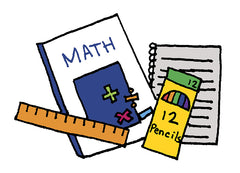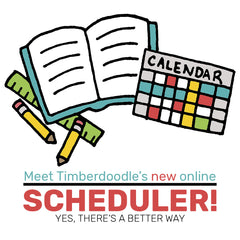Do you want to combine grades to save some costs?
Or are you striving for sanity while juggling multiple students?
We have some tips for you in today’s FAQ!
Hope: Our question for today is, “If I have a 5th grader, a 3rd grader, and a 1st grader, how can I combine my teaching? Is there any way to teach them all from the same curriculum or how can I do that?”
Deb: We’re not just talking about those particular grades. We’re talking about what to do if you’re combining multiple children and multiple grades. What does that look like? And of course the first question we have to determine is why you’re doing that. Are you doing it for economical reasons or you’re just doing it for sanity? Let’s first jump into “you’re doing it for economical reasons.” What can we do?
Hope: The first place I would look to combine would be history because that’s a natural for for multiple grades. I would pick a history level for one of those specific grades. Read it out loud as a group and have them do age-appropriate activities.
Deb: You wouldn’t even have to read it out loud. The most common history for that age group is going to be Story of the World and it’s got the audiobook, so you can put that in and they’ll do the work for you. It’s got age-appropriate activities through the book so you can start in 1st grade with Story of the World 1. Or you can go with Story of the World 4 that’s used in 4th grade. You can choose which ever one would be most pertinent to your family. So that particular history would be checked off your list.
Hope: Other than that it’s going to depend on what your goal is.
Deb: Say we’ve got science. If you are using the religious track of Timberdoodle the Berean science is perfect because you address all those ages. On almost every other page is an experiment that all children will enjoy. Then the information can be geared to the level of each child.
Pearl: There are age-appropriate notebooking activities for each age group in there as well. So they’ve already built that into the course.
Hope: That would be history and science. What are some other ways that we can combine grades?
Deb: Pearl, do you have any thoughts?
Pearl: I do. If you’re combining students for economical reasons I would look at the STEM kits and the Smart Games. With the Smart Games you just want to look at each one. Look at the recommendation for it and look at the challenge level. Typically look for a first through fifth grade range. You should be able to find one that will meet the needs of all children
Deb: And we can help. If you want to email us and say, “I’ve got children these ages and I only want to get one STEM item. What would you recommend?” We’re here to help. We can give you some direction on that. The same STEM kit could be used for all three children. For example, Plus-Plus is part of 1st grade. But you could use the same material for all three but you’d expect better quality of construction for a 5th grader than you would for a 1st grader. Let’s say that we recommend Zoob because that would be the 3rd grade option for STEM. Then I would encourage you to look in the handbook for ideas on how to use the Zoob for the 1st grader. It will say, maybe, build something that your grandfather uses. They could do that with the Zoob set. It wouldn’t use the Zoob like the 3rd grader’s going to use it, but it’s going to get them hands-on thinking.
Pearl: So you’re looking for STEM ideas from the 1st grade handbook and implementing them with the same resources from 3rd grade kit just to save the cost.
Deb: Again, these are things that we can help you with either over the phone or by email so that you can cut some costs and have some appropriate STEM activities for a wide range of children. So we’ve got STEM. What about art?
Hope: If you are doing art for 1st, 3rd, and 5th graders the 3rd grade art set is a perfect level to combine both other ends of the spectrum because you’re doing painting in that one. The set comes with four different paintings. That makes it a good one to either split out or to have everybody doing the same project at the same time.
Deb: In the same way the Do Art Coloring with Clay set is in the first grade kit. You could use the same picture but you would expect more out of the 5th grader to blend the colors, to put more texture in, to meet more of your expectations. A lot of our art kits have multiples in them that would appeal to all the children. So if you had three kids you probably want to get a Basic kit for each kid just right out of the chute because it will give them the age-appropriate math and language arts and the thinking skills. But again, you may be able to play around with the thinking skills and share, depending on which one you decide on, with the other two children.
Pearl: The games or the workbooks themselves?
Deb: I’m thinking the games. It depends on the age of the child. If we’re not working with these three ages but high school, junior high, some of this won’t necessarily apply.
Hope: If, on the other hand, you are looking for ideas of how to combine your teaching for your own sanity… So if you’re saying, “I’ve got three kids. I can’t imagine how I’m going to get anything else done during the day besides teaching these kids. And what in the world do I do with the other two while the while I’m teaching one of them?” We’ve got some ideas for that as well. First of all, look at your list and decide what are things that your child will be able to do…
Deb: What list are you talking about?
Hope: Our weekly checklist. So you’re going get your curriculum. There will be a checklist in there, either the one that comes with the kit if you just got the standard kit, or if you customized it you’re going to go to the customization scheduler on our website and make your weekly checklist. Now you’ve got a list of everything you want to get done during the week. You can look through there and see what can your child do independently. That’s a huge push for Timberdoodle to get your child learning independently.
Deb: As soon as they have learned how to read they should be starting to manage the bulk of their school.
Hope: Yeah. If it’s a math book or if it’s critical thinking skills, whatever it is, they should be able to read the directions, follow it, and do it independently. If they have an issue, come to you and say, “Hey, I can’t figure out this problem.” Once you decide what are their independent things, then you’ll want to decide what things they’re going to need assistance with. Then it’s a balancing act. Your 1st grader’s going to need assistance with let’s say, spelling, because you’re going be reading them a list. So let’s have your 3rd grader and your 5th grader watching their Math-U-See video and doing that independently while you’re working with the first grader.
Deb: Or doing their Smart Games… or their STEM… or their art… If you are working with reading with your 1st grader and your 5th grader cannot figure out their math and just needs a brief question answered, you could have your 1st grader work on a Smart Game for a few minutes while you help the other child. It’s kind of a little bit of a rodeo until you get it all figured out. But once you do it, once the kids assume responsibility for what they’re doing and they’re checking off their checklist, it all kind of gels. Maybe the first week will be a little crazy.
Again, we’re here to help. If you have a particular age range you’re thinking of and you’re saying, “But I’m working with a baby and a 5th grader and a 12th grader. Tell me how I can do this.” It’s going to be a little bit harder but there are things that we can do and suggestions we can make.
Hope: Expense wise, we can help you figure out what is overlapping and what to split out. Time management wise, really push on independent learning. Maybe you’re going to spend the first couple of weeks or the first month tooling your children up to become independent learners and the rest of your year will be so much easier that way. So I would say that is the biggest push.
Deb: That answers that question. If you have any add-on questions, be sure to drop us a line at mailbag@timberdoodle.com.
 Skip to content
Skip to content





